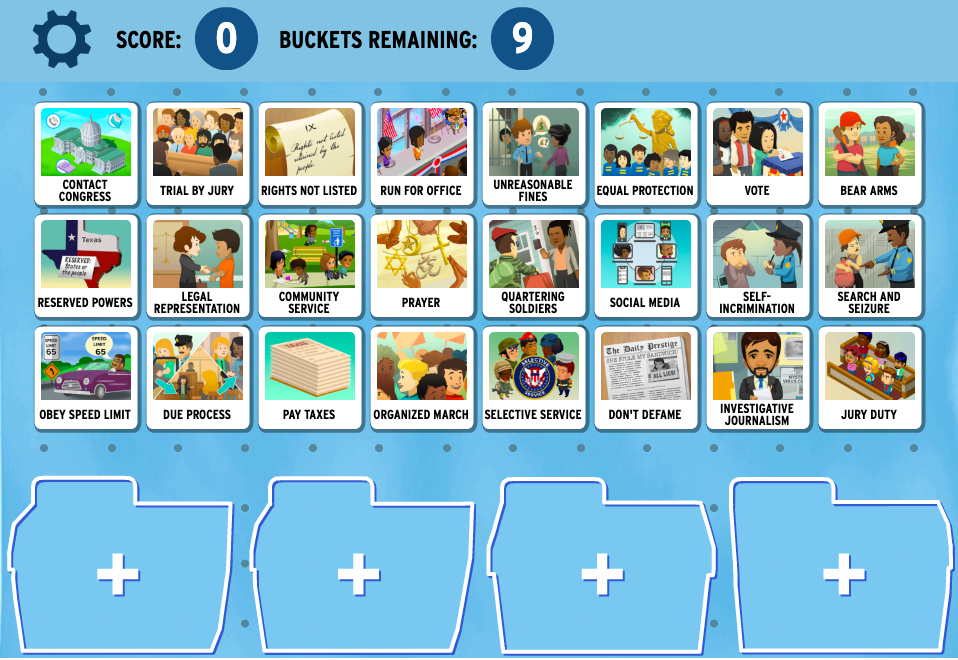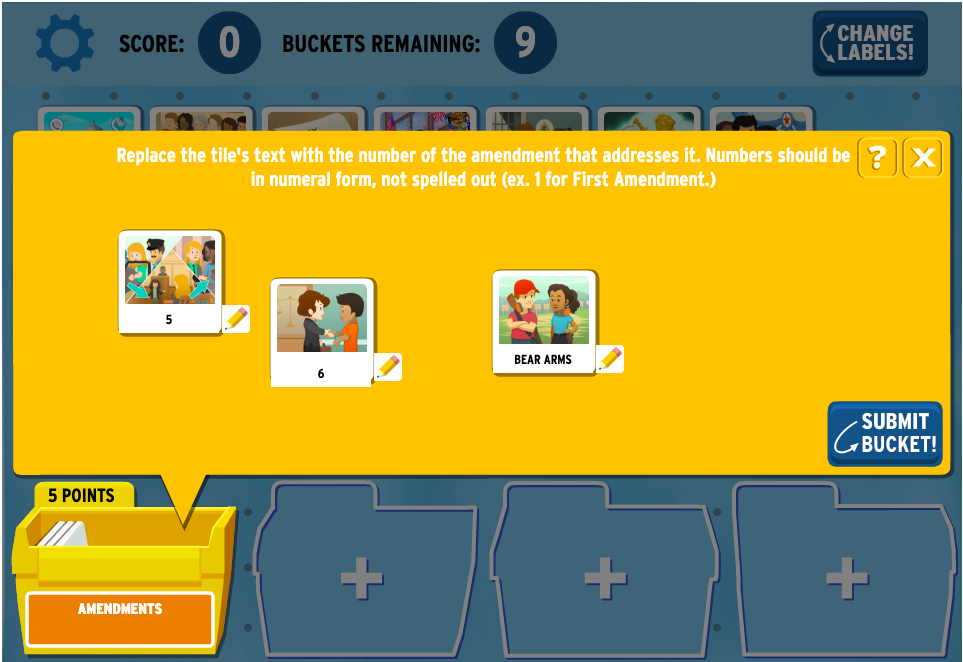
Review of Sortify, an iCivics Game About Citizenship
Sortify is an iCivics game developed in partnership with Brainpop. In this review, we’ll take a look at how to play the game, whether it’s any good or not, and how you might use it in your class to teach civics and government.
I’ll start up front by saying this isn’t one of their best games. But if you take it for what it’s worth, you’ll find that you might have a use for it as a quick review game to reinforce some basic ideas.

Gameplay of Sortify by iCivics
When you start a new game of Sortify, you’ll see the screen above. There are 24 tiles, each of which has a phrase like “Community Service” or “Pay Taxes” on it. These represent the rights and responsibilities of U.S. citizens.
At the bottom of the screen are four blank “buckets.” Your job is to sort the 24 tiles into categories that make sense and to use the fewest possible number of buckets in doing so.

When you put a tile into a new bucket, you’ll see this screen with nine different label options. Based on the label you choose, you’ll want to select other tiles that fit in that bucket.
So for example, I put “Prayer” into this bucket. The label “First Freedoms” would be appropriate, and I could later add the tile for “Organized March.”
You’ll see that some labels are worth more points – like First Freedoms – while other tiles are worth less points – like Bill of Rights.

The orange labels, worth 5 points per tile, also require you to take an additional step beyond just sorting the tiles. Once you place the tile in the bucket, you need to re-label the tile to fit that bucket.
For example, this bucket as the label Amendments. I put the “Bear Arms” tile in it. This is the 2nd Amendment, so I’d have to delete the words “Bear Arms” and replace it with “2”. You can see that I already added tiles with amendments 5 and 6.
And that’s it. When you think you’ve put everything you can in a bucket, you hit “Submit Bucket.” You can then create a new bucket and continue to sort tiles.
It’s possible to sort all of the tiles using only four buckets. Depending on how you choose to sort them, you’ll use more or less buckets, and score more or fewer points.
Teacher Resources for Sortify by iCivics
Sortify comes with a teacher’s guide developed by iCivics. It’s a pretty sparse four page document with a list of objectives, a page on gameplay, some conversation starters, and extension ideas.
The learning objectives denoted in the teacher’s guide are:
- Recognize and recall rights and responsibilities of U.S. citizens
- Identify active ways in which citizens can participate in government and contribute to the common good
- Relate like terms and concepts by deducing shared relationships
So from the get go, the bar is set pretty low. This is intended to be a review level game based on recognition and identification. There is some sorting and higher level thinking, but it’s minimal.
One of the extension ideas is to have students create their own Sortify game, and that does sound like a somewhat interesting activity.
When you’re done, you’ll get a score. But there isn’t a certificate to print like there is in some other games.
First Impressions of Sortify by iCivics
I’ll just start off by saying that I’m not impressed by Sortify. Compared to some of their more in depth games like Race to Ratify and Cast Your Vote, it just seems to fall short.
That being said, there are a few good things.
This could be a good, quick review on Constitutional rights. If students sort items into the “Amendments” bucket, they have to identify the amendment number.
There are some interesting conversations to be had around the ideas of “Communal Good,” “Voluntary Responsibilities,” and “Participate in Government.” But the vast majority of the tiles are just rights protected by the Bill of Rights or the Amendments. Once you’ve sorted those, there’s not a lot left to discuss and to organize.
Gameplay was short. The first time I played, I was able to finish in less than ten minutes. I think the second time, when I went for a higher score, I was done in less than five. So on a positive note, it won’t take much classroom time.
I think there’s some potential here, but as it is I’m just not a fan. If the focus was on the amendments only, and you could sort the constitutional amendments into various buckets (i.e. freedom of expression, rights of accused, voting rights) that might be a more useful activity. Also, if the focus was more on the responsibilities of citizenship, I think you’d have much deeper conversations.
Potential Classroom Uses for Sortify by iCivics
This activity definitely lends itself more to a review than anything else. If you plan on using this in class, you’ll want to make sure that you students have already learned about the amendments to the Constitution and to the various rights and responsibilities of citizenship.
In that respect, this could be a quick homework assignment to give for a review. It won’t take long, and the game is straightforward enough that students can play it on their own.
The teacher’s guide suggests that you have students play this in pairs or groups. This does have the potential for creating more conversation. If you’ve got some classroom time to spare, go ahead and give it a try.
Final Thoughts on Sortify by iCivics
This game didn’t wow me, and I doubt it’ll wow you either. But if you take it for what it’s worth – a low level review game of recall and comprehension – then it’s not bad. It doesn’t take a long time to play, and it can be a fun way to get students to review and reinforce some of these ideas about citizenship and the Constitution.
Have you played Sortify in your class? Am I missing something, and it’s really a great game? Let me know your thoughts below, or head over to the Facebook page and leave a comment there.
You can play Sortify on iCivics here.
And for more ideas on how to make your civics lessons more engaging, check out this post on how to teach government in a fun way.